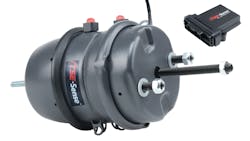TSE Brakes introduces smart air brake actuator
CLEVELAND, Ohio—After three years in the making, TSE Brakes announced the launch of its TSE-Sense Smart Air Brake Actuator during the American Trucking Associations’ Technology & Maintenance Council 2021 Fall Meeting. The system is designed help fleets and drivers analyze brake data for both real-time response and preventive diagnostics.
The proper functioning of brake systems can be affected by inadequate maintenance and inspection procedures, which may lead to unscheduled repairs and downtime, increase fuel costs, higher operating costs, and even accidents. And one of the most popular out-of-service violations on the road is caused by a brake out of adjustment, noted Patrick McNamara, TSE’s VP of sales and marketing.
“It’s more complicated today for people to be able to look underneath, and most drivers wouldn’t recognize it on their own anyway,” he said during a TMC press conference.
In addition, McNamara explained that more than half of the trailer fires that occur on the road are caused by some element between the brake and the brake chamber.
Comprising TSE’s smart brake actuators and a data integration box (DIB), TSE-Sense continuously monitors brake stroke at each wheel end. TSE-Sense can diagnose brake issues in real-time, including non-functioning brakes, dragging brakes, overstroke conditions, emergency spring failure, cross-axle brake imbalance, and more.
The TSE-Sense brake actuator measures the brake stroke of each actuator, monitors the emergency spring condition, and logs the brake performance data in the DIB. By performing brake diagnostic checks, the system verifies that each actuator and the entire brake system is functioning properly, McNamara pointed out.
Having the ability to monitor the brake system will show patterns of behavior that can indicate brake safety issues. In addition, monitoring can:
- Increase fuel efficiency and reduce operating costs by reducing fuel usage by allowing fleets to be aware of brake drag, which decreases wheel-end rolling resistance.
- Reduce unscheduled repairs and downtime by providing the capability to know if the pushrod stroke of each brake chamber is functioning properly. If the stroke length is increasing or is out of adjustment, repairs can be performed prior to failure and in a timely manner.
- Provide notice of “out of stroke” condition for the brake, a key item in every DOT inspection.
- Reduce accidents by enabling fleets and drivers to identify and repair a brake issue before the issue impacts the brake systems function.
This article originally appeared on FleetOwner.com.
About the Author

FleetOwner Staff
FleetOwner serves executives and maintenance management of commercial truck fleets that operate five or more vehicles, delivering business information about operations, vehicle maintenance, industry regulations and information-management technology. Engaging more than a half million commercial vehicle professionals every month, FleetOwner maintains the largest audience of commercial truck fleet executives available to the industry.
